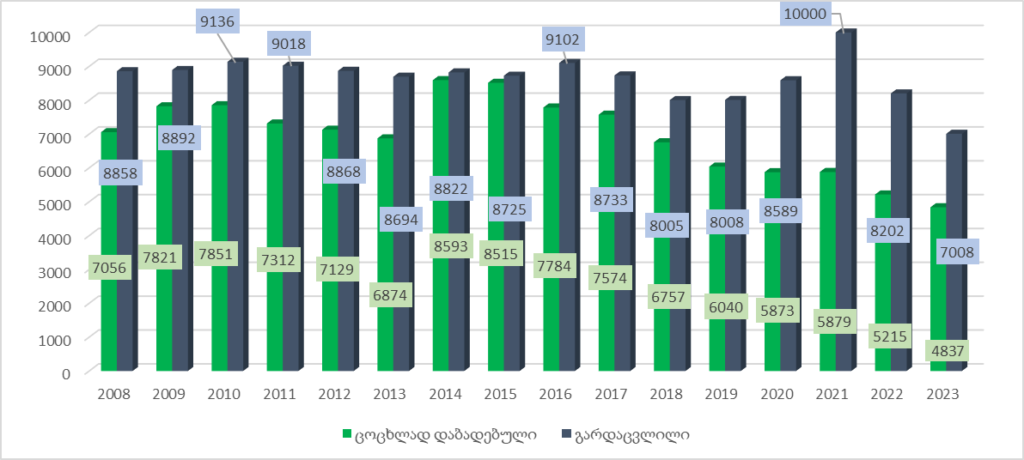Temur Tsamtsishvili: “The number of people born in Kutaisi previously constituted up to 3,000 but now has decreased to 1,700. The situation is similar in the entire Imereti region, including Vani, Samtredia, Khoni, Tskaltubo, Baghdati, Terjola, Zestaponi, Kharagauli, Tkibuli, Sachkhere and Tchiatura. The annual rate of natural increase in Imereti amounts to -2,987, with 5,215 births and 8,202 deaths.”
Verdict: FactCheck concludes that Temur Tsamtsishvili’s statement is MOSTLY TRUE.
Resume: The birth rate has generally decreased in Georgia and the rate of natural increase – representing the difference between births and deaths – is negative, suggesting that deaths surpass births. This tendency is evident in the Imereti region. The number of births in Kutaisi reached or exceeded 3,000 in 2008-2009. Furthermore, the natural increase was positive (more births than deaths). However, the trajectory reversed from 2010, leading to a higher number of deaths as compared to the number of births by 2014. Regarding the aggregated data of Imereti, a positive natural population change was never recorded from 2008 to 2023 and the birth rate has been exhibiting a downward trend. The politician cited data of 2022 when 1,767 people were born and 2,118 died in Kutaisi. GeoStat uploaded the document containing 2023 primary demography statistics on 28 March. Notably, the number of births and deaths has decreased even further (1,582 and 1,843, respectively) but the rate of natural increase has remained negative both in Kutaisi and Imereti as a whole. In particular, the natural increase in Kutaisi was -351 in 2022 and -261 in 2023. A total of 5,215 people were born and 8,202 died in 2022 whilst 4,837 were born and 7,008 died in 2023 in Imereti. Thus, the natural population change constituted -2,897 in 2022 and -2,171 in 2023.
The opposition politician omits the fact that the highest birth rate in Imereti was recorded in 2014 which was under the governance of the Georgian Dream political party. Additionally, he overlooks that the highest death rate in Georgia was recorded in 2010, excluding the pandemic year of 2021 when COVID-19 impacted the death rate in Georgia, leading to a surge in the number of deaths in 2020 and 2021. Furthermore, it is crucial to take migration data into account, as more people have emigrated than returned, according to GeoStat data. Notably, the age group of individuals who have remained abroad is typically of reproductive age, further contributing to the downward trajectory of low birth rates.
Considering all of the above, FactCheck concludes that Temur Tsamtsishvili’s statement is MOSTLY TRUE.
Analysis
United National Movement politician Temur Tsamtsishvili claimed: “The number of people born in Kutaisi previously constituted up to 3,000 but now has decreased to 1,700. The situation is similar in the entire Imereti region, including Vani, Samtredia, Khoni, Tskaltubo, Baghdati, Terjola, Zestaponi, Kharagauli, Tkibuli, Sachkhere and Tchiatura. The annual natural increase in Imereti amounts to negative 2,987, with 5,215 births and 8,202 deaths.”
It is crucial to highlight that the birth rate has generally decreased in Georgia and natural increase – representing the difference between births and deaths – is negative, suggesting that deaths surpass births, according to GeoStat data. The number of births in Georgia in 2023 is 5% lower than the figure recorded in the previous year. Specifically, 4,837 people were born in Imereti in 2023, placing the region fourth in terms of births. This region ranks fourth in the death rate data as well, with the number of deaths amounting to 7,008 last year. The aforementioned data suggests that the rate of natural increase in Imereti is negative, as deaths surpass births by 2,171.
However, Temur Tsamtsishvili cited data of 2022 when the natural population change in Imereti constituted -2,897. The number of births amounted to 5,215 whilst the number of deaths constituted 8,202 in 2022, including the data of Kutaisi and other municipalities of Imereti. However, both births and deaths decreased in 2023. The data of 2023 was made available after the politician’s statement.
Graph 1: Number of Births and Deaths in Imereti in 2022 and 2023

Source: National Statistics Office of Georgia
The graph above highlights that the number of births in Imereti dropped by 387 in 2023 as compared to 2022, indicating a 7.2% decrease. Furthermore, the number of deaths was lower than that of the previous year by 1,194, or 14.6%. Whilst the rate of natural increase in 2023 remained negative, it was, nonetheless, lower than in 2022.
The politician compared the demographic indicators of 2022 to those of 2008 and discussed all municipalities in Imereti. Hence, we analysed the data from 2008 to 2023.
Table 1: Number of Births and Deaths in Imereti, 2008-2023
| მუნიციპალიტეტი | 2008 | 2009 | 2010 | 2011 | 2012 | 2013 | 2014 | 2015 | 2016 | 2017 | 2018 | 2019 | 2020 | 2021 | 2022 | 2023 | ||||||||||||||||
| დ | გ | დ | გ | დ | გ | დ | გ | დ | გ | დ | გ | დ | გ | დ | გ | დ | გ | დ | გ | დ | გ | დ | გ | დ | გ | დ | გ | დ | გ | დ | გ | |
| ქუთაისი | 2829 | 2781 | 3102 | 2801 | 2258 | 2261 | 2085 | 2179 | 2124 | 2168 | 2018 | 2085 | 2674 | 2072 | 2665 | 2174 | 2469 | 2250 | 2369 | 2097 | 2270 | 1978 | 2021 | 2011 | 1965 | 2354 | 1978 | 2778 | 1767 | 2118 | 1582 | 1843 |
| ბაღდათი | 210 | 331 | 236 | 332 | 311 | 395 | 292 | 394 | 276 | 385 | 269 | 381 | 336 | 405 | 353 | 410 | 284 | 453 | 279 | 382 | 249 | 348 | 211 | 325 | 215 | 388 | 208 | 423 | 188 | 382 | 175 | 328 |
| ვანი | 235 | 380 | 264 | 379 | 358 | 456 | 334 | 455 | 315 | 443 | 305 | 437 | 358 | 415 | 388 | 420 | 356 | 487 | 345 | 468 | 325 | 411 | 244 | 381 | 217 | 401 | 253 | 423 | 206 | 373 | 199 | 319 |
| ზესტაფონი | 680 | 928 | 758 | 931 | 840 | 1013 | 785 | 1005 | 755 | 986 | 731 | 968 | 864 | 969 | 913 | 914 | 833 | 946 | 802 | 881 | 724 | 851 | 664 | 839 | 617 | 896 | 676 | 1035 | 571 | 816 | 537 | 727 |
| თერჯოლა | 318 | 522 | 359 | 525 | 501 | 642 | 471 | 644 | 445 | 631 | 436 | 627 | 496 | 598 | 525 | 626 | 474 | 610 | 452 | 644 | 377 | 569 | 357 | 567 | 349 | 575 | 337 | 676 | 316 | 529 | 330 | 453 |
| სამტრედია | 665 | 802 | 738 | 809 | 708 | 808 | 661 | 798 | 651 | 789 | 627 | 773 | 770 | 803 | 741 | 739 | 674 | 881 | 645 | 821 | 552 | 714 | 472 | 691 | 471 | 726 | 464 | 845 | 411 | 765 | 350 | 602 |
| საჩხერე | 341 | 548 | 387 | 551 | 523 | 665 | 493 | 669 | 469 | 658 | 461 | 657 | 635 | 604 | 611 | 575 | 584 | 623 | 606 | 630 | 477 | 541 | 451 | 583 | 420 | 571 | 453 | 725 | 384 | 578 | 376 | 498 |
| ტყიბული | 294 | 371 | 321 | 367 | 321 | 375 | 296 | 367 | 286 | 357 | 272 | 347 | 291 | 420 | 264 | 430 | 260 | 437 | 253 | 404 | 196 | 404 | 181 | 397 | 195 | 371 | 141 | 438 | 165 | 378 | 145 | 319 |
| წყალტუბო | 573 | 868 | 640 | 871 | 814 | 1020 | 762 | 1020 | 725 | 998 | 706 | 990 | 804 | 898 | 711 | 875 | 695 | 884 | 675 | 859 | 570 | 812 | 528 | 867 | 536 | 873 | 510 | 993 | 461 | 877 | 435 | 774 |
| ჭიათურა | 448 | 642 | 500 | 641 | 586 | 718 | 545 | 710 | 522 | 694 | 506 | 682 | 709 | 797 | 704 | 734 | 569 | 718 | 592 | 732 | 511 | 652 | 446 | 676 | 456 | 711 | 447 | 811 | 376 | 675 | 381 | 540 |
| ხარაგაული | 176 | 300 | 198 | 299 | 284 | 367 | 265 | 366 | 249 | 356 | 242 | 352 | 315 | 425 | 323 | 382 | 277 | 396 | 265 | 359 | 226 | 365 | 211 | 330 | 213 | 348 | 187 | 386 | 178 | 323 | 167 | 275 |
| ხონი | 287 | 385 | 318 | 386 | 347 | 416 | 323 | 411 | 312 | 403 | 301 | 395 | 341 | 416 | 317 | 446 | 309 | 417 | 291 | 456 | 280 | 360 | 254 | 341 | 219 | 375 | 225 | 467 | 192 | 388 | 160 | 330 |
| სულ | 7056 | 8858 | 7821 | 8892 | 7851 | 9136 | 7312 | 9018 | 7129 | 8868 | 6874 | 8593 | 8515 | 7784 | 7574 | 6757 | 6040 | 5873 | 5879 | 5215 | 4837 | 7008 | ||||||||||
Source: National Statistics Office of Georgia
Evidently, the negative natural increase did not occur solely under the governance of the Georgian Dream. The number of deaths consistently surpassed the number of births from 2008 to 2012 under the governance of United National Movement. The trend persisted in the subsequent period, from 2013 to 2023. Furthermore, a positive natural change in population was recorded only in 2008 and 2009 in Kutaisi under the governance of the United National Movement from 2008 to 2012. The aforementioned rate turned negative in the subsequent years and continued under the governance of the following political party until 2014. The rate then turned positive until 2020 when COVID-19 significantly impacted the death rate. The death rate surged in the pandemic years of 2020 and 2021 throughout the entire country, consequently deteriorating the natural population change in both Kutaisi and Imereti as a whole. Despite the above, the negative rate of natural increase remained in the post-pandemic years, in 2022 and 2023.
Graph 2: Number of Births and Deaths in Imereti from 2008 to 2023

Source: National Statistics Office of Georgia
Notably, whilst the total number of births has never surpassed the total number of deaths in Imereti in the aforementioned time period, births surpassed deaths on multiple occasions in several municipalities, including Kutaisi, under the governance of both the United National Movement and the Georgian Dream. The highest death rate amounted to 9,136 and occurred in 2010 in Imereti, excluding the pandemic year of 2021. The death rate was almost as high in 2011 and 2016, constituting 9,018 and 9,102, respectively.
Several underlying factors should be considered whilst talking about the birth rate. Specifically, Kutaisi is the largest and most urbanised city in Imereti, leading the nearby municipal population to migrate to the aforementioned administrative centre. However, the number of births in 2023 was 1,247 lower as compared to 2008. Furthermore, migration plays a crucial role amongst other contributing variables. The number of people who have left Georgia over the past nine years amounts to 719,000 whilst the number of those who have returned slightly exceeds 505,000, suggesting that the net migration in Georgia is negative – more Georgian citizens are emigrating than those returning, according to GeoStat data. Additionally, the age group of individuals who have remained abroad is typically of reproductive age, further contributing to the downward trajectory of low birth rates.
Whilst Tsamtsishvili cites the number of births in 2008 in Kutaisi, he omits the subsequent data from 2010 and 2011 when, respectively, 571 and 744 fewer people were born and the number of deaths exceeded the number of births. Furthermore, the politician overlooked the fact that the total number of births in Imereti peaked in 2014 under the Georgian Dream’s governance. Considering all of the above, FactCheck concludes that Temur Tsamtsishvili’s statement is MOSTLY TRUE.








